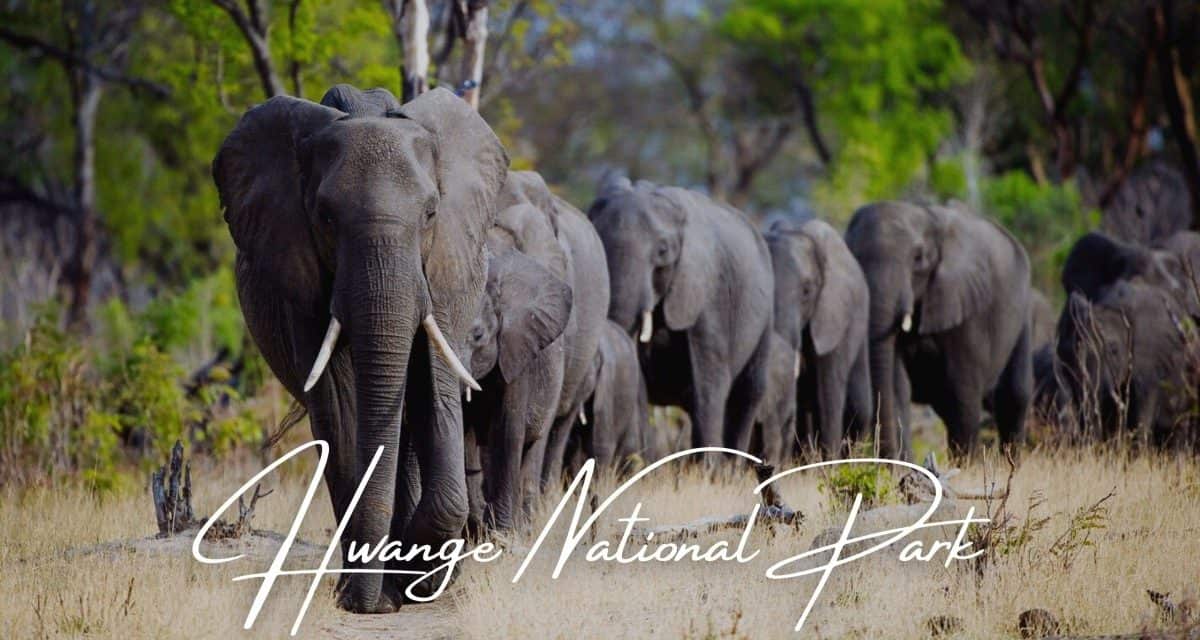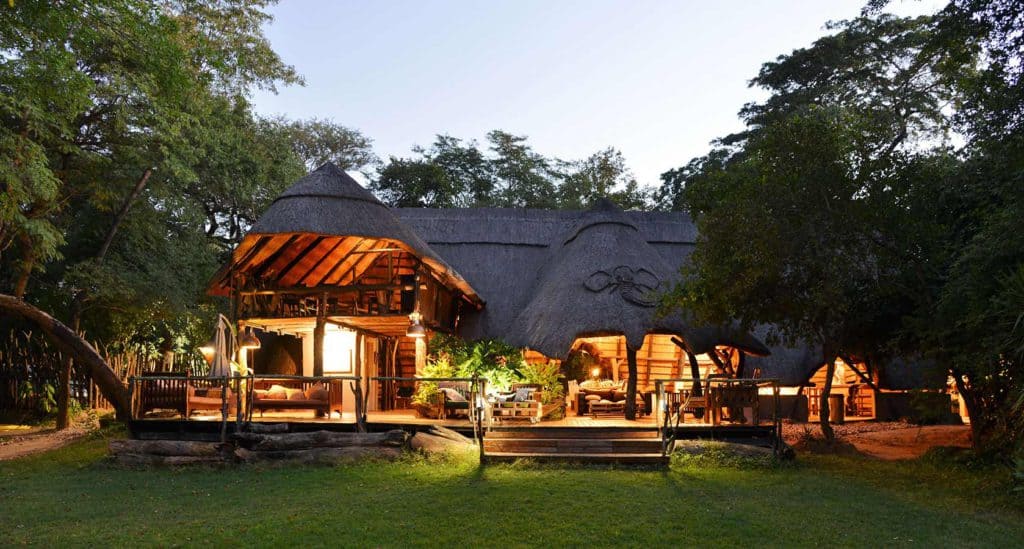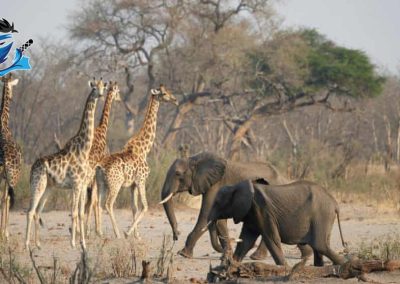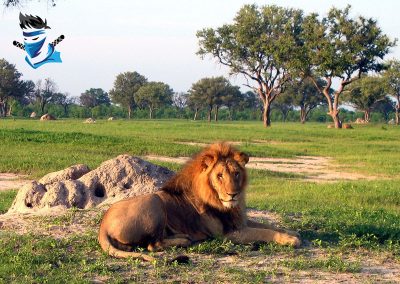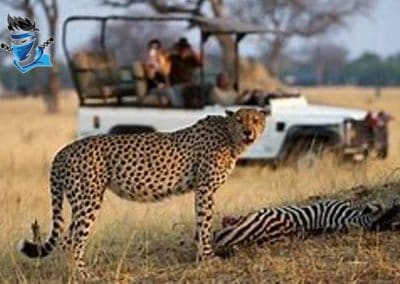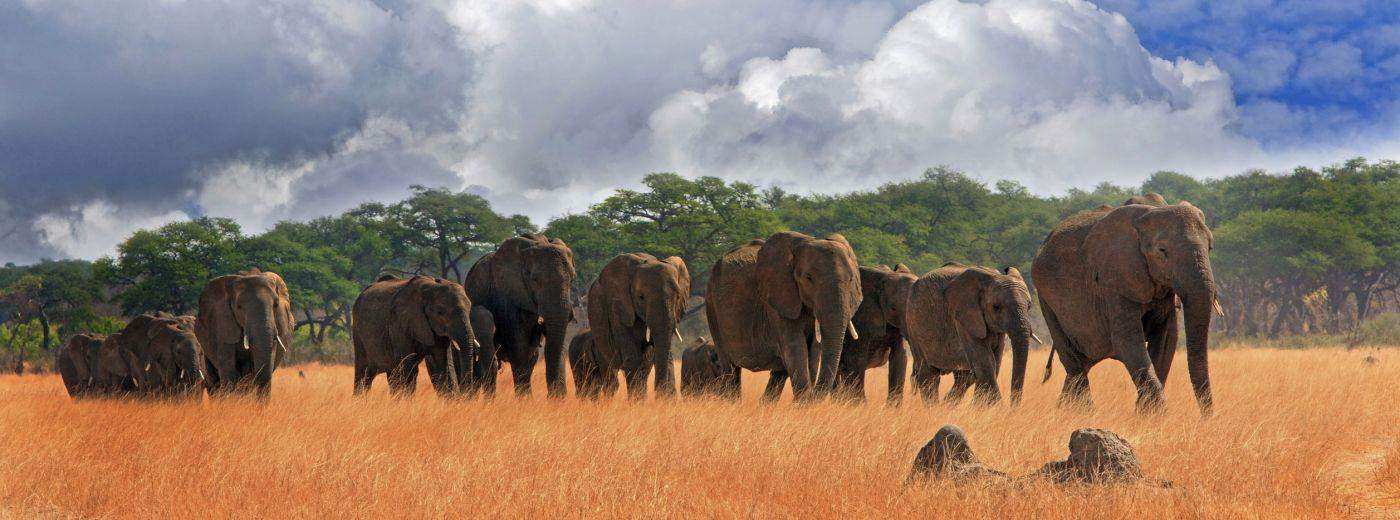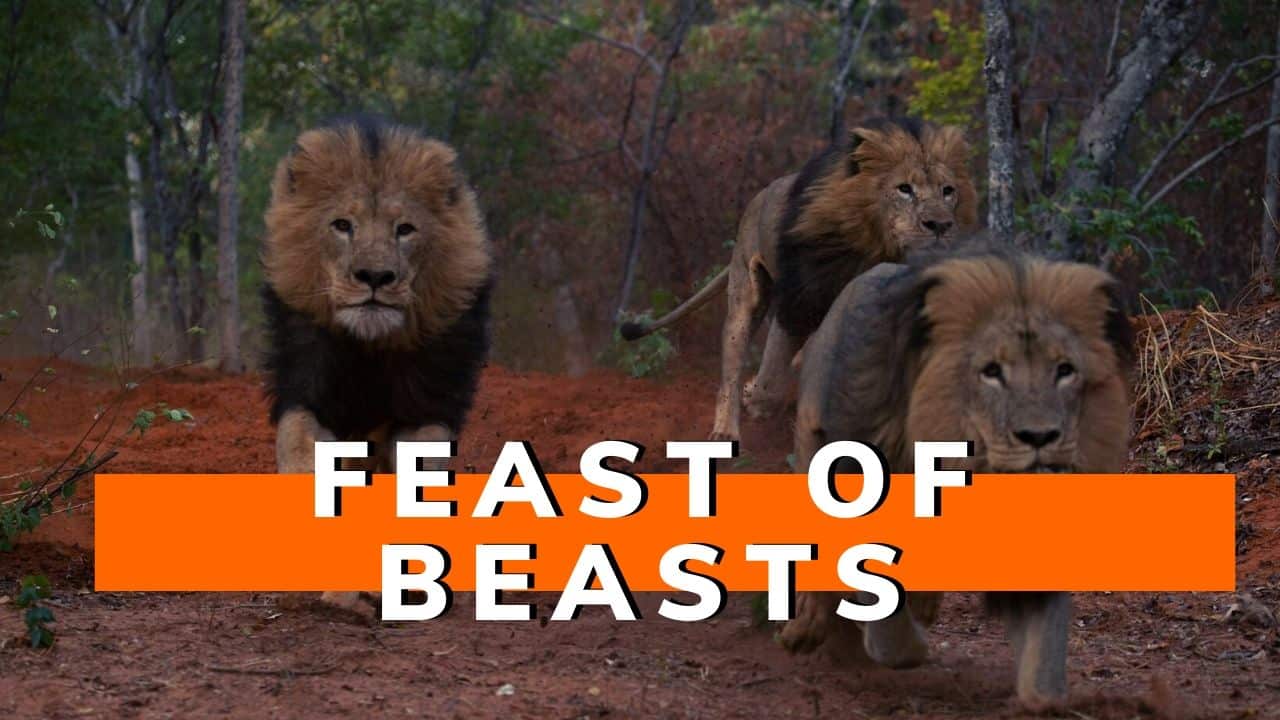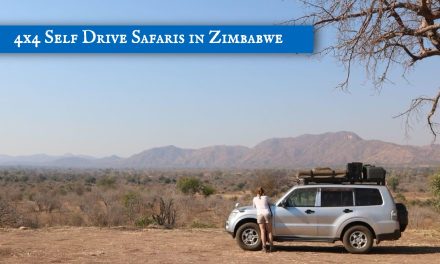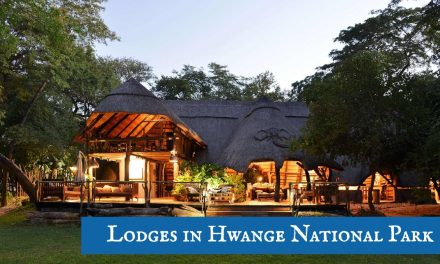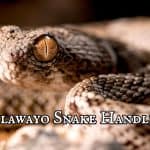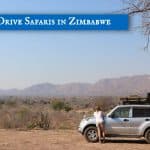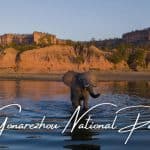Table of Contents
Guide to Hwange National Park
In the western part of Zimbabwe, Hwange National Park is a wildlife reserve where you can see large elephant herds, lions, African wild dogs, and a variety of other species. You can visit the Masuma Dam to see the lions and other animals, or go a little further and visit the Bumbusi National Monument to see the 18th-century ruins and pre-colonial rock carvings. The elevated viewing platform at Nyamandhlovu Pan allows you to observe the magnificent view of the surrounding landscape.
To experience the park’s wildlife, take a self-drive tour. The park is well-maintained and there are many places to stop for lunch or relax. You can also visit the viewing platforms and hides, and find many campsites along the road. Most campsites are located near water points, making them accessible even in the middle of the day. But remember to pack a warm jacket, as camping involves exposure to the elements. It is best to visit during the dry season to see the animals and avoid the cold nights. It is common to find frost and even a chilly night in this park.
A trip to Hwange National Park is an ideal way to experience the diverse wildlife that inhabits this national park. The park’s ecosystem is highly diverse and relies on a series of waterholes for its animals. Friends of Hwange help maintain these waterholes so that animals can survive in the dry season. This helps ensure that game viewing in the park is excellent. You can also see 400 species of birds in Hwange, including elephants and buffalo.
If you want to see more animals, it is recommended that you visit during the dry season, when the area is dry. This season lasts from late June to October. During this time, animals are easier to spot in the bush. This is because they concentrate on water sources. Since water is such an important resource in Hwange, the water holes are maintained by pumps year-round. If you’re planning a safari to Hwange, make sure to include this in your itinerary.
The Hwange National Park is an ideal destination for a safari. The park offers a diverse range of activities, including walking safaris. For those who want to spend more time in the park, there are also rail-car excursions. Guests can sip drinks while watching lions and sable from a rail car. At Hwange, the scenery is breathtaking and you’ll be amazed at the diversity of animals and birds.
The Hwange National Park is situated in the northwest corner of Zimbabwe, close to the small town of Dete. It is a scenic hour’s drive south of Victoria Falls. In the park, you’ll find several options for accommodation. Depending on your budget, you can stay in a luxury lodge or camp in an affordable, yet luxurious tent. There are also caravan sites and camping spots available.
Hwange is an excellent safari destination, and its large population of elephants is the main attraction. There are also more than 400 recorded bird species and 100 mammal species. In addition to elephants, Hwange is home to more than 200 different mammal species. The park is a wildlife lover’s paradise. If you have never visited a national park, don’t miss the opportunity to visit this incredible place!
Located on the eastern edge of the Kalahari sands, the Hwange National Park has no permanent surface water. Instead, animals rely on a series of waterholes to survive. The area is very arid and rarely has rain, so the park’s waterholes are extremely important to the animals. It’s also important to remember that the landscape in Hwange has two seasons.
During the dry season, the Hwange National Park is not suitable for agriculture. The area is primarily a protected area and is home to the largest elephant population in Africa. Because of the lack of permanent natural water, the park was not originally designed to support humans. Therefore, the park’s first purpose was to protect the elephants. Conservationists worked to ensure that the elephants could survive without the human presence of humans.
Accommodation in Hwange National Park
If you want to experience the wildlife of Zimbabwe’s most famous national park, there are several places to stay. You can choose from luxury tented camps or simple, solid three-star camps. Some lodges have eco-friendly policies, which helps preserve the natural habitat. Some of them even have their own vegetable and fruit gardens. If you’re looking for the best Hwange National Park accommodation, consider staying at the Simon Mills Safari Lodge.
Bushbuck Lodge: Located about ten kilometres north of the Sinamatella Resort, this private concession has just four safari tents. The camp is designed to make viewing the wildlife easy and comfortable. The rooms are furnished with teak and feature unique designs. Some rooms have views of the waterhole and a variety of birds. The staff can also help you find a bird-watching reference book. The price of this Hwange National Park accommodation is US$350 per person, excluding taxes and services.
The Bushbuck Lodge offers a full range of facilities for your stay in Hwange National Park. There is an outdoor and indoor bathroom, and you’ll be able to take a hot shower or enjoy a shower in the middle of a game-filled day. The accommodation is eco-friendly, but the rooms can be very basic. Those who are travelling with children should not try to go on safari without a guide.
Camp Hwange is the newest establishment in the Hwange National Park. It offers guests eco-friendly comforts and an underground hide. The spacious rooms are decorated in Teak, and the location provides a wonderful panoramic view of a waterhole. Those who wish to see a variety of birds can also opt to stay at Camelthorn Lodge. The lodge is nestled among camelthorn trees, and it features an underground hide and a restaurant.
There are many options for accommodation in Hwange National Park. There are several camps and lodges that cater to the needs of holidaymakers. The main camp, owned by Zimparks, is located near the entrance to the park. It offers comfortable self-catering and camping sites. The Hwange National Park is a great place to visit with children. It is also a good choice for families with children.
Besides the park itself, there are also a number of accommodations that are situated inside private concessions. The Hide, which is rated as “Best Safari Lodge in Zimbabwe” on several occasions, is a luxurious Hwange National Park accommodation. The lodge is located on the Park’s edge and is situated in a prime location. Its guests can experience the wildlife of Hwange from all sides of the Lodge.
Elephants are a popular sight in Hwange. There are numerous animals to see, and the camp has a unique underground hide for guests. The camp also offers a range of amenities, including a spa, a swimming pool, and a gourmet restaurant. Although the price of these accommodations varies, the quality of the service and the facilities are worth the price. You will be pampered with great food and the luxury of a safari hide.
If you are looking for luxury Hwange National Park accommodation, there are several options to choose from. One of the best options is the Ivory Lodge. The luxurious lodge is situated on a private concession of 6,000 acres. The lodge offers spectacular views of the wildlife in the park. The luxurious rooms feature high-rise thatches and canopies. The presidential suite is a special treat for couples.
The Lukosi River Lodge is 10 km from the Sinamatella Resort. It is only open during the rainy season and only one group can be accommodated at any given time. The Lukosi River Lodge comprises two camps, which are elevated boardwalks and platforms. The rooms offer beautiful views of the wildlife. During your stay at the lodge, you can visit the anti-poaching unit, which is located just across the road.
Accommodation in Hwange National Park is important for the health and safety of all guests. It’s important to know the risk of malaria in the area and take the necessary precautions. Fortunately, most accommodations in Hwange are malaria-free and have the most modern facilities. Whether you’re on a business trip or a holiday, the Kizingo Cottages are an ideal choice. There are many self-catering options available in this park.
Other National Parks around Zimbabwe
When to visit Hwange National Park
When to Visit Hwange National Park in Zimbabwe? The West African country is home to large herds of elephants and lions. The Masuma and Mandavu dams also provide a good viewing platform to view the wildlife. Bumbusi National Monument is an 18th-century ruin and a pre-colonial rock carving site. An elevated viewing platform is located on Nyamandhlovu Pan.
The best time to visit Hwange is October to April. The park features seasonal changes, with rainy summers and dry winters. While winters are dry, you can expect great game viewing. Wildlife congregates around the manmade waterholes and the leaves become sparse. The temperature will be below freezing on some nights. When to Visit Hwange National Park in Zimbabwe: The park is a must-visit for nature lovers.
When to Visit Hwange National Park in Zimbabwe: There are several seasons in the year that are ideal for visiting this park. The dry season offers the most beautiful landscapes and is the best time to observe elephant herds. However, if you are looking for an amazing bird-watching experience, you should plan your trip for December to March. The rainy season also provides the most scenic views of the area.
When to Visit Hwange National Park in Zimbabwe: The best time to visit Hwange is between October and April, when the birds are at their peak. The park contains approximately 400 species of birds, including lions, leopards, cheetahs, and elephants. Some of the other animals you may see in Hwange include cheetahs, hyenas, antelopes, and three-banded coursers.
If you are interested in observing the birds of Hwange, the best time to visit is from October to April. During this period, you can observe more than 400 species of birds, including both European and Asian species. The rainy season brings lush vegetation and a healthy bird population. In the dry season, you should avoid heat waves in the area. Aside from the rainy season, you can visit Hwange National Park during the dry season for the best sightings.
The dry season in Hwange is not the best time to visit the park. The dry season is the best time to view the animals. The temperatures in this area are low and can even drop to single digits at night. You should take warm clothing for the early morning game drive in an open game drive vehicle. You can find many other wildlife species in the park, including the endangered Roan antelope.
During the dry season, the park is closed, which means that there are fewer animals and higher rainfall. But this does not mean that you should not visit during these months. You can still enjoy the beautiful scenery and see the wildlife in the park. There are many opportunities to see the animals in Hwange, including the Big Five. But if you’re planning to see the rhinos, try to go to the park early in the morning.
Hwange National Park Activities
Hwange National Park is a wildlife sanctuary in west Zimbabwe. The park is home to African wild dogs and large herds of elephants. The area includes several lakes, including Mandavu Dam. The Mandavu Dam is a popular attraction because of its large herds. Masuma and Mandavu Dam are great places to view lions and elephants. Visit Bumbusi National Monument to see pre-colonial rock carvings and ruins. The Nyamandhlovu Pan has an elevated viewing platform.
The park is a great place to observe wildlife. During the dry season (November to October), many animals gather around the waterholes. In the Wet season (November to April), animals tend to disperse and are less easily observed. There are many activities in the park, including bird watching, game drives, and cultural tours. Guests can enjoy any of these activities while in the park. Alternatively, if they wish to do more hiking, cycling, or scuba diving, there are several places that offer these experiences.
The best time to visit Hwange is during the dry months of November and October, when animals gather around waterholes. However, during the Wet season (November to April), the park is quieter and the animals are more scattered. This is also a great time to watch birds. In the Wet season, the animals are more easily seen and the park is less crowded. If you’re visiting for the first time, consider visiting the park in the Wet season to get a sense of what to expect.
The best time to visit the park is when the rainy season is not yet over. The climate in the park is semi-arid, and the seasonal changes are quite marked. In the dry season, the animals tend to congregate around shallow pans and man-made waterholes. In the rainy season, vegetation explodes into life and the animals disperse to the more remote areas. During this time, you will have the opportunity to observe birds up close, especially if you choose to go on a game drive.
Depending on the season, you can choose between a day of birding. There are different activities for both sexes. In the dry season, the animals throng around waterholes. If you visit during the Wet season, there are fewer animals, and the park is more private. In both seasons, the animals will be more scatter throughout the park, but you can always opt for a game of golf or go on a safari.
Guests will have plenty of opportunities to learn about local culture and history during their stay in Hwange National Park. During the Wet season, the animals are more scattered and less likely to be seen. The park is known for its abundant wildlife, and the wildlife in the park is plentiful. There are numerous activities to choose from. Aside from birding, visitors can engage in a variety of other types of activity in Hwange.
The diversity of the park’s wildlife is another attraction. This park is one of the few places in Africa where all five of the Big 5 safari species can be found. Other animals that can be found in the park include cheetahs, hyenas, and antelopes. This is the best time to view the animals in the park, as they will be gathered around the waterholes.
In addition to birding and wildlife viewing, tourists can participate in activities such as hiking, horseback riding, and horseback riding. You may also see lions or other large animals. There are numerous other activities in the park. The best time to visit is from November to October. During this time, the animals are most abundant in the dry season and are easy to spot. During the Wet season, they are more scattered.
Guests will have the opportunity to participate in a variety of activities in the park. During the dry season, the animals are in their habitats. During the Wet season, the animals will be spread out and will occupy the waterholes. This means that visitors will have a better chance of seeing lions in the wild. There are many other activities in the park. They should not miss any of these activities.
History of Hwange National Park
The pre-colonial ecosystem of Hwange National Park is a remarkable achievement in the conservation of wildlife and biodiversity. This conservation effort was largely successful because it aligned religious beliefs and good agricultural practices. Indigenous peoples in the area practiced regular crop rotation and believed in maintaining an equilibrium between humans and their natural habitats. This helped them harvest more crops and increase the fertility of the land. These farming techniques helped prevent deforestation and maintain the health of ecosystems.
Today, Hwange is a thriving conservation area, home to more than a hundred species of mammal. It is also home to Africa’s Big 5. This land was declared a national park in 1930, when it was deemed fit for no other purpose. Throughout the nineteenth century, white settlers transformed the land from a natural balance to an unbalanced one. In the process, white hunters began to exploit the area for timber and trophies.
Before being designated a national park, Hwange was a wildlife reserve. The boundaries were drawn so that the park could remain free from human interference. This prompted the establishment of a number of windmills to pump water into these waterholes, making them essential for the survival of animals. The windmills were built by Ted Davidson, the first warden of the Wankie National Park, and later by other wardens. The Friends of Hwange maintain the windmills and boreholes.
The area was designated a reserve in 1928, which meant that it could no longer be used for farming. This decision saved the park from the devastating effects of big game trophy hunting. The area was not fit for other purposes, and was re-claimed by the local government. In the years following, the land’s condition began to recover. With the introduction of electricity, waterholes were created. During the dry months, the windmills became the only reliable source of water, reducing the number of conflicts between humans and animals outside of the park.
Originally a wildlife reserve, the Hwange National Park is now a UNESCO World Heritage site. The park contains more than 100 species of animals and is home to Africa’s Big 5. However, it is difficult to find a permanent water source in the park, so the wildlife in the area depends on man-made waterholes. The area has no permanent surface water and is dependent on irrigation through windmills.
In the early twentieth century, the area was home to Nhanzwa bushmen. Its name is derived from the chief’s last name. During the nineteenth century, the park’s boundaries were set in a region without a reliable water source. As a result, the wildlife that migrated out of the park was at risk of conflict with humans. As a result, the conservationist Ted Davison built a series of windmills to supply the arid months with water. This largely eliminated the threat of the white hunters, and the original windmills still exist today.
Hwange National Park FAQs
What is Hwange National Park known for?
Hwange is most known for the impressive concentration of elephant that are attracted to the park’s waterholes during the Dry season. With over 100 species present, Hwange has the widest variety of mammals of any national park in the world. Its claim to fame is one of the largest elephant populations in the world.
Is Hwange National Park Safe?
Hwange National Park is, in our opinion, a safe destination, especially if you’re travelling on an organized tour. A self-drive safari is an option too but always get local advice on road conditions and safety before heading off.
Why do people visit Hwange National Park?
It is known for one of the densest concentrations of wildlife in Africa, especially elephant and buffalo, and for its year-round wildlife viewing. With some 100 mammal species, it also has one of the highest mammal diversities in Africa.
Is Hwange national park fenced?
It’s one of Africa’s top national parks
The park having no fencing allows the animals to freely roam the vast grasslands. This offers a day filled with adventuring around the area.
What is the largest national park in Zimbabwe?
Hwange!
Zimbabwe’s largest national park, the elephant stronghold of Hwange is a game-rich area roughly the size of the Bahamas that was once the royal hunting grounds of the Ndebele warrior king Mzilikazi. It was proclaimed a national park in 1929.
How big is Hwange National Park?
5,657 mi²
Hwange National Park/Area
It was established in 1928 as a game reserve, and as a national park in 1930. The park’s area of 5,657 square miles (14,651 square km) is largely flat and contains fine hardwood forests of mukwa and Zimbabwean teak.
Are there giraffes in Hwange?
Hwange is one of the few places in Zimbabwe to see giraffe. Unusual antelope to look out for include greater kudu, gemsbok, sable and roan antelope. Spotted hyena is commonly seen at dawn and dusk, and the population of wild dogs is one of the largest in Africa.
Can you see the Big 5 in Hwange?
While you can find all of the Big 5 at Hwange, the park is particularly famous for its thriving population of elephants. With about 50,000 of them throughout the park, it’s thought to be one of the largest populations in the world.

